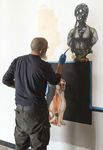UMMA Commissions Meleko Mokgosi: Pan-African Pulp 2019-2021
←
→
Page content transcription
If your browser does not render page correctly, please read the page content below
Storytelling is at the heart of Meleko Mokgosi’s For the project, Modern Art: The Root
artistic practice, which comprises painting, of African Savages (2012–16), Mokgosi
drawing, text-based pieces, sculpture, and questions the established narratives of western
installation. With careful consideration of institutions by analyzing and responding to
narrative styles employed across cultures, issues of power and cultural bias revealed
Mokgosi investigates political and social issues in the labels and interpretive texts from the
such as colonialism, history, and identity. exhibition African Art, New York, and the
His process involves considerable research Avant-Garde, presented at The Metropolitan
evidenced by the range of diverse references Museum of Art in New York in 2012.
to scholarly books, music, film, art exhibitions, Similarly, with Walls of Casbah (2009–14),
oral traditions, politics, and popular culture, he focused on interpretative labels for the
and he adopts a distinct perspective drawing exhibition Walls of Algiers: Narratives of
from psychoanalysis, cinema, and theory the City (Getty Center, Los Angeles, 2009).
(primarily post-colonial). While deeply critical, Mokgosi’s questions
Directing each project’s narrative and comments are not only poignant and
(he frequently works in multi-layered projects spot on, they also demonstrate his dry wit
that can span several years and encompass and sense of humor.
a variety of series and sub-series) Mokgosi’s Responding to the location and
paintings are deliberately staged in engrossing context, Mokgosi conceived of a new
installations—he often hangs several canvases series for his UMMA commission entitled
butted up against each other without any gaps, Pan-African Pulp. Inspired by the history of
which heightens the cinematic effect—featuring Pan-African groups in Detroit, Pan-African
vibrant scenes of fictional (and occasionally Pulp comprises four parts—a vinyl wall
living and/or historical) figures. The paintings work, a text piece, a painted mural, and
are frequently complemented by sculpture, reproductions of a manifesto and several
drawings, prints, and text-based works, vintage posters. The overall project investigates
enriching the narrative with additional cultural the global development and impact of
references. Two recent projects exemplify his Pan-Africanism—the international movement
ongoing interests and processes. The sequence aiming to unite ethnic groups of sub-Saharan
of figurative paintings in Pax Kaffraria African descent and its links to African
(2010–14), for one, uses Botswana, South liberation movements. Responding directly
Africa, Zambia, and Zimbabwe as case studies to the history, work, impact, and legacies
in a narrative probing topics from colonial of organizations such as the Black Nation
history, globalization, and trans-nationality, of Islam, The Republic of New Afrika,
to whiteness, ‘African-ness,’ and post-colonial Shrine of the Black Madonna (Black
aesthetics. Pax Afrikaner (2008–11), a Christian Nationalism), Pan-African Congress,
companion project to Pax Kaffraria, delves and United Negro Improvement Association,
into the notion of nation-state identity. Mokgosi’s research drove him to reconceptua-
Produced in response to rampant xenophobia lize a link between Pan-Africanism in the
in southern Africa, the two projects explore U.S. and on the African continent. And while
(mental and physical) violence towards black he previously considered the Pan-Africanist
foreigners in southern Africa. A more recent approach to be limiting and reductive, this
series, Democratic Intuition (2013–19), endeavor provoked him to reevaluate the
unfolds over eight chapters, and includes movement and how it was manifested both
paintings and sculptures looking at common, across the globe and locally in Detroit.
everyday experiences and the roots and For one element, Mokgosi turned to
implications of democracy in southern Africa, popular African photo novels—also called
on an individual and public level. The series “look books”—from the 1960s and 1970s,
also addresses issues such as art history, a genre often considered as a precursor
history, gender, labor, protest, power, and to African cinema. African Film (Drum
literary and visual narrative strategies, such Publications), for example, follows Lance
as allegory. Spearman, a private eye in the mold of JamesBond, on his crime-fighting adventures. shares a wall with a selection of posters from Set in a modern environment, young Africans Pan-African movements founded in Detroit could easily relate to the hero and his stories. and Africa in the 1960s as well as a few The photo novels—a less expensive alternative designed by Mokgosi, which demonstrate to filmmaking—are composed of staged a shared promotional strategy and visual shots of action scenes and follow a script language. conveyed with speech bubbles (in English), Drawing on the rich history of mural combining elements of comic books, films, painting as a form of expression and its role and magazines. These commercial photo in promoting the cause and messages of novels mostly avoided overt political issues, liberation movements, Mokgosi’s mural looks focusing instead on aspects of fantasy at the complexities of the notion of blackness and fiction in hip, contemporary language. and how it’s (mis)understood from European The Spearman stories never addressed and non-European perspectives and contexts. apartheid directly, even though Drum Painted in the social realist style, the picture Publications was based in South Africa. is anchored by an image of a monument to However, several issues subtly acknowledge independence, the Zambian Freedom Statue the political and social context at the time (1974), a burly man breaking free of the of their production, with references to the chains of colonialism. The heroic monument is diamond trade in South Africa or the Cold complemented by a cast of characters plucked War. African Film and others were hugely from seemingly disparate sources including popular across the continent, even for those a pair of wrestlers, a boy holding two dogs who were unable to read English, because the by their collars, and two seated men in suits— pictures steer the narratives. The publications all under a hopeful sunburst and rainbow. also provided a platform for a new generation Finally, stories from Setswana literature, of African writers and actors. The UMMA in the Setswana language, reflect the tradition commission features a massive, 42 1/2-foot of oral storytelling, another aspect of Pan- wall of blown-up panels from issue 117 Africanism, in texts displayed around the of African Film, for which Mokgosi has ribbon of the balcony. Mokgosi told the tales replaced the original texts in the speech to students, who were then filmed retelling balloons with his own dialogue. Introducing them in English, in their own words, and those this relatively obscure piece of African videos are accessible via a QR code. As in popular culture to an American audience, the game of telephone, the stories morph and and at this scale, emphasizes the broad appeal evolve with each interpretation. of detective stories, while illustrating the Through stories told with images, universal language of photo novels, comic objects, and texts Meleko Mokgosi evaluates books, graphic novels, magazines, and cinema. history and cultures through narratives On an adjacent wall an enlarged reproduction that are both personal and deeply universal. of the manifesto from the 1969 Pan-African He challenges established traditions and roles Cultural Festival in Algiers has been annotated within these different cultures and from the with Mokgosi’s notes and edits addressing distinct perspective of an artist, philosopher, the rationale and notions of “Africanity,” scholar, and member of the African diaspora. African unity, and Pan-Africanism. The ideas In a climate of increasing division and put forth in the manifesto were influenced disparity, the ideas and subjects addressed by the recent publication of Frantz Fanon’s here are more relevant than ever. 1961 book, The Wretched of the Earth, which analyzes the dehumanizing effects Ali Subotnick of colonialism. In a similar fashion to his Guest Curator critiques of institutional texts for Modern Art: The Root of African Savages and Walls of Casbah, here Mokgosi highlights the complexities of liberation movements and their respective propaganda. The manifesto
UMMA Commissions invites makers to create site-specific
works inside and outside the Museum’s walls as it seeks
ALL
to bring the practices and concerns of artists in direct
contact with the Museum’s spaces, collections, and public. WELCOME
Lead support is provided by Lizzie and Jonathan Tisch. Meleko Mokgosi, FREE
Pan-African Pulp, 2019.
Additional generous support is provided by the University
Artwork © Meleko Mokgosi.
of Michigan African Studies Center and the Department Photography: Jeri Hollister
of Afroamerican and African Studies. and Patrick YoungYou can also read



























































